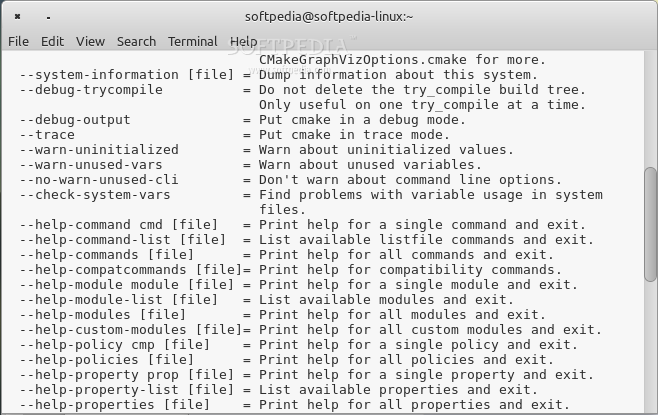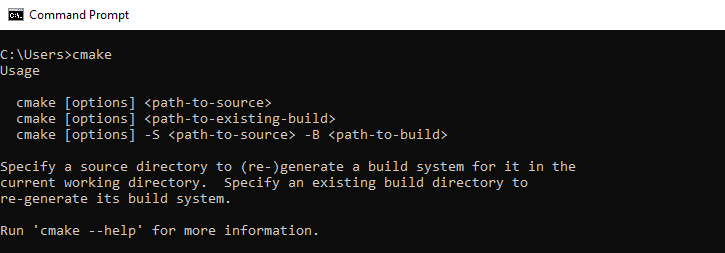
- CMAKE COMMAND NOT FOUND HOW TO
- CMAKE COMMAND NOT FOUND INSTALL
- CMAKE COMMAND NOT FOUND ARCHIVE
- CMAKE COMMAND NOT FOUND CODE
- CMAKE COMMAND NOT FOUND DOWNLOAD
mkdir build & cd buildĪ project structure looks as follows: helloworld/

Recommended to create separate directory to store files that will be generated by CMake. Helloworld/CMakeLists.txt cmake_minimum_required(VERSION 3.0) Once the file is opened, add the following code:Ĭreate CMake configuration file called CMakeLists.txt: nano CMakeLists.txt We can check version of CMake: cmake -version Testing CMakeĬreate a new directory to store project files and navigate to this directory: mkdir helloworld & cd helloworld
CMAKE COMMAND NOT FOUND INSTALL
Run the following commands to update the package lists and install CMake: sudo apt update Install CMakeĬonnect to Raspberry Pi via SSH.
CMAKE COMMAND NOT FOUND HOW TO
This tutorial shows how to install CMake on Raspberry Pi. CMake is not a compiler or build system but rather it generates build files that can be used to compile source code.

CMAKE COMMAND NOT FOUND CODE
Only if you are in dire need of a specific cmake version, opt for the source code method.CMake is a tool that uses configuration file called CMakeLists.txt to generate standard build files such as makefiles on Unix systems, Visual Studio project files on Windows, and so on. If you desire the latest version, use the snap version. In my opinion, using the apt version of cmake is what you should go for. $ cmake -versionĬMake suite maintained and supported by Kitware (/cmake).Īs you can see, I have CMake successfully installed. When you run the command cmake -version, it will output the version of CMake.īelow is the output from my build of CMake. To check if CMake was installed, run the cmake command and use the -version (or -version) option. Below is the command that should be executed: sudo make installīy running this command, necessary files related to CMake will be placed into their correct directories. You can easily install CMake using the make command. Now that CMake has been built, it is time that CMake is installed. When the make command finishes execution with the progress reaching 100%, CMake has been compiled. This time, you will be able to see progress with a percentage. Your output should look similar to the image attached below. This process will also take quite a while, depending on how powerful your CPU is. Once the make command starts, the code will start compiling. Now, we do exactly what the bootstrap output tells us to do. Once the bootstrapping process completes, you will see a line that says, "CMake has bootstrapped. So sit back and feel like a hacker as random scrolling text appears on your screen. This may take some time, depending on your CPU horsepower. When the script starts executing, you will see output similar to what is shown in the image below. A bootstrapping script is provided, which helps build CMake locally. Now that the source code is available locally, it is time to build CMake.
CMAKE COMMAND NOT FOUND ARCHIVE
When the extraction is complete, change the directory to the one created by archive extraction.
CMAKE COMMAND NOT FOUND DOWNLOAD
Once you download the source archive from Github, extract it using the following command: tar xf That means I will avoid using any release version that ends with the -rcX string, where X is a number.Īt the time of writing this, the latest version of CMake is version 3.22.5, so I will be using that as a reference. From the Github releases page of CMake, download the file that says "Source code (tar.gz)."įor this guide, I will use the latest version (GA) of CMake.

Visit the git repo of CMake and get either the latest version or the version you desire. Now that the dependencies are installed proceed to the next step. sudo apt install build-essential libssl-dev They are build-essential and libssl-dev and thankfully, they are already available in the Ubuntu repositories. To build cmake, some dependencies are required. Go to this route only if Step 1: Install dependencies Now, this is a complicated process and it is certainly not everyone's cup of tea.

Method 2: Install latest cmake from the source code (not recommended) Wait for a few seconds or minutes for the process to complete and then enjoy it. I would advise removing existing cmake version you installed in APT package format to avoid conflicts: sudo apt remove cmakeĪll you have to do is to use the following command: sudo snap install cmake -version Thanks to the Snap packaging, you can get the latest cmake version straight from the developers. Method 1: Install the latest cmake on Ubuntu using Snap


 0 kommentar(er)
0 kommentar(er)
